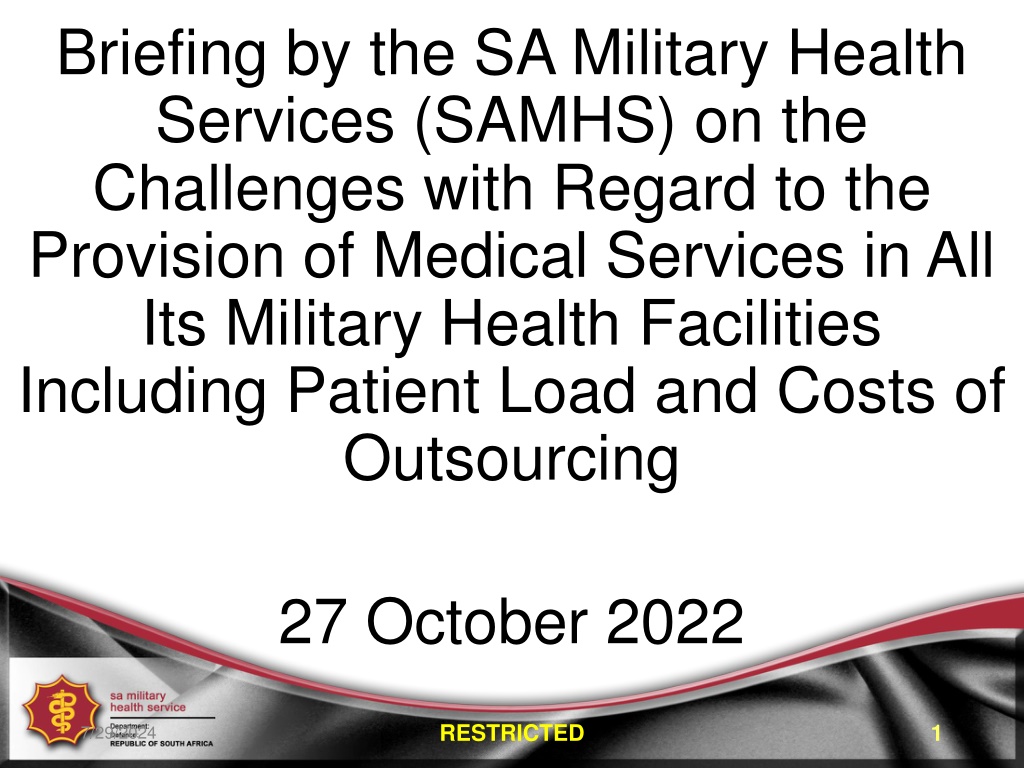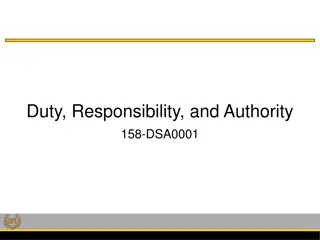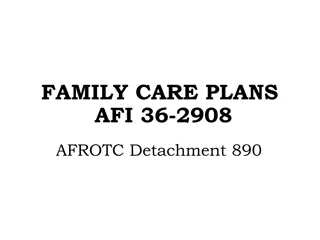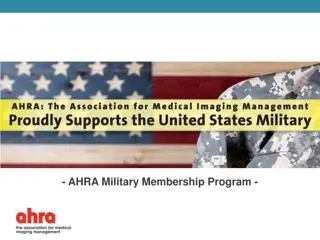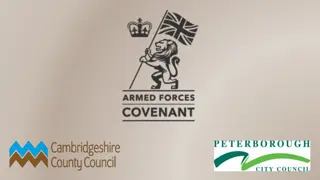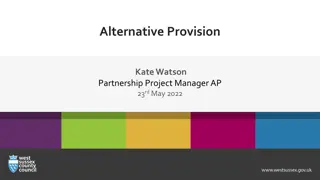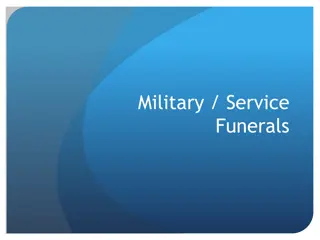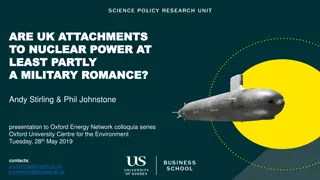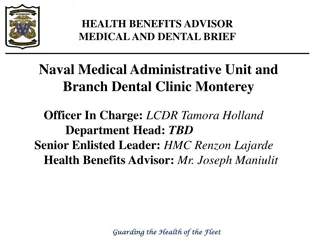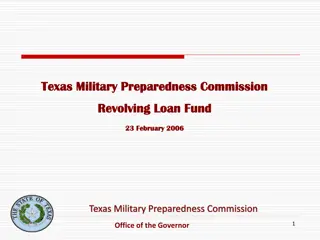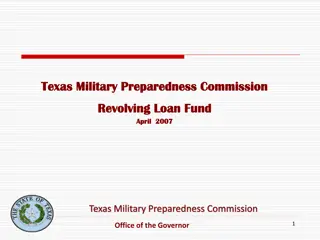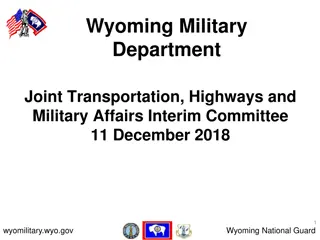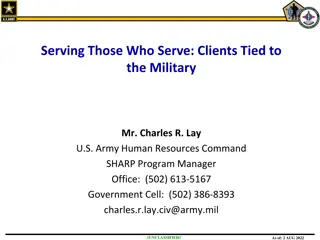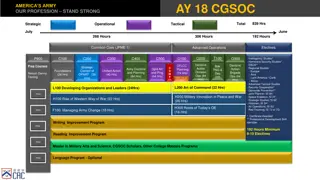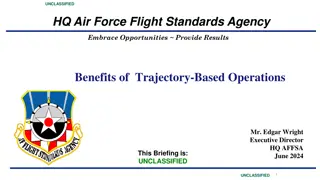Challenges in Provision of Medical Services by SA Military Health Services
The SA Military Health Services (SAMHS) faces challenges in providing medical services in its facilities, including managing patient load and costs of outsourcing. SAMHS aims to deliver affordable and quality healthcare services while working within resource limitations. The briefing outlines the mandate, outputs, and goals of SAMHS in supporting the South African National Defence Force and its members.
Download Presentation

Please find below an Image/Link to download the presentation.
The content on the website is provided AS IS for your information and personal use only. It may not be sold, licensed, or shared on other websites without obtaining consent from the author. Download presentation by click this link. If you encounter any issues during the download, it is possible that the publisher has removed the file from their server.
E N D
Presentation Transcript
Briefing by the SA Military Health Services (SAMHS) on the Challenges with Regard to the Provision of Medical Services in All Its Military Health Facilities Including Patient Load and Costs of Outsourcing 27 October 2022 RESTRICTED 1 7/29/2024
AIM To Brief Command and the Staff Joint Standing Committee On Defence on the SA Military Health Services (SAMHS) Challenges Regarding the Provision of Health Services, including Patient Load and Costs of Outsourcing RESTRICTED 2
BACKGROUND (1/5) SAMHS MANDATE Defence The SA Military Health Service must at all times be structured and funded at State cost to provide an all-inclusive multi-disciplinary health capability to the SANDF and its members: Provided that the cost of services to serving members shall be the liability of the State Act and General Regulations determine: SAMHS argues that it is executing the mandate, but that the biggest challenge is to provide affordable and quality healthcare services within the limitations of resources RESTRICTED 3
BACKGROUND (2/5) SAMHS Outputs: Output 1: A health support capability of five medical battalion groups, including accompanying field hospitals and one specialist medical battalion group for deployed and contingency forces (Force Health Protection) Output 2: A comprehensive multidisciplinary military health service for a projected patient population of (193 000) 302 000 members per year (Force Health Sustainment) Defence of RSA - Force Support RESTRICTED 4
BACKGROUND (3/5) Military Health Programme: Provision of quality health services for the full range of military operations and members of the South African National Defence, their families and others eligible for healthcare provided by SAMHS The expected outcomes for SAMHS include an increase in combat readiness, population health improvement, and affordable best- quality military healthcare RESTRICTED 5
BACKGROUND (4/5) SAMHS is at the forefront of delivering health services to members of the South African National Defence Force, their dependents, military veterans, Presidency, Foreign Dignitaries (DIRCO), and Approved Clientele SAMHS total patient population amassed to an estimated 193 000 people within the country, including the President, Deputy President and Foreign Dignitaries and approved clientele on request and against payment RESTRICTED 6
BACKGROUND (5/5) Many of the challenges emanate from the funding gap. The challenges are exacerbated by: HR imbalances Sub-optimal supply chain management (Tedious and Cumbersome) Equipment Obsolete Equipment Unserviceable Prime Mission Equipment PME) and Main Medical Equipment (MME) Poor Standard of Health Care Facilities (Old infrastructure, costly to repair e,g 1 Mil Hosp plumbing) RESTRICTED 7
BUDGETARY CONSTRAINTS (1/2) Funding Gap (Estimated Underfunding at Rb4,5 ) SAMHS a health sub-program but not receiving health budget SAMHS looking after all Services but receiving a SAMHS budget slice 8 RESTRICTED
BUDGETARY CONSTRAINTS (1/2) Funding Gap (Estimated Underfunding at Rb4,5 ) Capital Budget (Strategic Capital Assets). SAMHS capital allocations funded through the General Defence Account (and not the Special Defence Account for the other Services) Allocation levels never exceeding 3% of total SAMHS allocation since Financial Year 2004/05 (0% percent allocation in FY16/17, and for the 2022 MTEF cycle still below 1% with the majority of this funding earmarked for photocopier contractual obligations) Operational Budget. Squeeze on day-to-day unit combat readiness and Service force-preparation, jeopardising the overall capability and operational readiness 9 RESTRICTED
BUDGETARY CONSTRAINTS (2/2) Funding Gap (Estimated Underfunding at Rb4,5 ) Creating maintenance backlog and reduced stock levels- affecting availability of Prime Mission Equipment (PME), Health Infrastructure and Main Medical Equipment (MME) Impact on retention of scarce skills (overtime payments) SAMHS budget allocation is not in line with medical inflation, oncology drugs, pharmaceuticals, etc Medical Inflation above normal inflation Equipment procured overseas 10 RESTRICTED
HUMAN RESOURCE (1/6) Structure Anomalies SAMHS approved structure (as in 2000) is 10 748 (COE of Rb6,2) However National Treasury has placed ceiling of 6 612 (COE ceiling of Rb3,7) Deficit of 4 136 frozen/unfunded posts 11 RESTRICTED
HUMAN RESOURCE (2/6) Structure Anomalies SAMHS structure is not proportionate to level of expected provision of service: Joint Force Employment (JFE) commitments. ResF Component available but not funded Support to Services/Divisions Force Preparation Activities Support to Military Families (Based Orientated Care) SAMHS does not have permanent structures for JFE capabilities. Personnel are drawn from Base-Orientated structures/pool (hospital and sick bays)/creating gaps when these resources are withdrawn. Capabilities are used interchangeably for JFE requirements, base orientated and force preparation support. Capabilities are grouped as and when they are required to execute a specific operational task 12 RESTRICTED
HUMAN RESOURCE (3/6) Structure Anomalies Maldistribution of Specialist posts relative to need - 2000 vs 2022 patient dynamics (Specialists posts) SAMHS is not capable to operate military hospitals, base hospitals and health facilities supporting SANDF training institutions at the required level of service provision (24/7 care) 1 Mil Hosp 2 Mil Hosp 3 Mil Hosp 8 x Base Hospitals at Area Military Health Units SANDF Training Units 13 RESTRICTED
HUMAN RESOURCE (4/6) Recruitment, appointment and retention of uniformed healthcare professionals personnel There is also a shortage of specialists which is affecting the provision appropriate specialized care and lack of (bed) admission of some patients Experiencing a higher number of vacancies within the operational emergency care environment COE for HCPs (Payment of Allowances): Unable to pay overtime of more tan 30% to HCPs. No authority to pay overtime of more than 30% since March 2022 (Impacting on service delivery). 14 RESTRICTED
HUMAN RESOURCE (5/6) The non-availability of specialist staff impacts directly on the quantity and quality of the training service offered by academic hospitals such as 1 Mil Hosp Inability to rejuvenate and fill all vacant post is taking a huge toll on existing staff as the responsibilities of vacant positions had to be distributed amongst the remaining personnel resulting in added workload and burn-out - morale 15 RESTRICTED
HUMAN RESOURCE (6/6) SAMHS plan on the basis that we should be able, on a routine basis and without over-stretching personnel, to carry out a number of concurrent military operations of differing scales of effort. However, SANDF operations have consistently exceeded the planned level of activity in the most recent times Op MISTRAL (FIB, Framework Force, Quick Reaction Force and lately Artillery Battery) Op MISTRAL s Quick Reaction Force and Artillery Battery are not part of the JFE requirements Op VIKELA (Not on JFE) Op PROSPER (2021 looting) OP CHARIOT (N3 and N2) Frequency and the concurrency operations means that SAMHS elements do not have sufficient for recuperation from previous operations, making it difficult to reconfigure for new operations and prepare for future roles 16 RESTRICTED
EQUIPMENT (1/2) Prime Mission Equipment (PME) and Main Medical Equipment (MME) Unserviceability and Obsolescence. This is the result of decades of non- investment SAMHS faces equipment obsolescence and most of the ambulances and other PME are ageing. MME and PME are retained beyond their prudent retirement dates. This lowers the operational status of equipment fleets Obsolete MME increases the risk of inaccurate diagnosis, medicinal errors, inappropriate or unnecessary treatment resulting in litigations, long waiting periods and costly outsourcing Old Unserviceable Equipment. Not meeting standards for accreditation (1 Mil Hosp, Nursing College, School for Military Health Training) Poor Defence Industry Support (Armoured Ambulances) 17 RESTRICTED
EQUIPMENT (2/2) Prime Mission Equipment (PME) and Main Medical Equipment (MME) Unserviceability and Obsolescence. Ambulances. The organisation has 692 ambulances on strength with an average age of 23 years. Out of this number, 186 are serviceable, 215 are repairable and 184 are beyond economic repairs There is a greater need and demand for an in-house ambulance service for active patient SANDF population of 178,115 (2021). Unfortunately, SAMHS facilities do not offer this service due to a lack of resources and such cases are outsourced at high expense Military hospitals also require ambulances for emergency/trauma call-outs and the routine transportation of patients between external service providers and the hospital Added to this mix are Military Health Units who need ambulances to support military units in their force preparation exercises and other activities 18 RESTRICTED
COMBAT READINESS SAMHS is struggling with its overall full spectrum Combat Readiness (CR) levels. Result of several consecutive years of budget cuts A perfect CR is having sufficient, well equipped, well supplied people in the right place at the right time to deal with any given situation according to the SANDF Ordered Commitments/Joint Force Employment (JFE) guidelines Given the limited funds, it is impractical and unaffordable for SAMHS to maintain medical elements constantly at JFE combat readiness standards/levels at all times 19 RESTRICTED
HEALTH CARE FACILITIES A high number of military health facilities: Many of them are old and have become unsafe for occupation Not meeting standards for accreditation (1 Mil Hosp, Nursing College, School for Military Health Training) This is affecting the quality of healthcare services 20 RESTRICTED
SUB-OPTIMAL SUPPLY CHAIN MANAGEMENT (1/2) Tedious and Cumbersome supply chain Management Processes (not tailored for health unique requirements) Medical Waste Removal Contract - Month to month quotation for the past six months. Current expenditure amounts to R300 000 per month. Extension of 1 Mil Hosp Coal Contract Boiler System - Month to month since expiry in April 2022. 1 Mil Hosp Laundry Services Contract - Month to month for the past 7 (seven) months (DCPD and CPSC). Current expenditure amounts to R500 000 per month. 1 Mil Hosp Cleaning Services Contract - Month to month since expiry in November 2021 21 RESTRICTED
SUB-OPTIMAL SUPPLY CHAIN MANAGEMENT (2/2) Lack of Defence Support (DENEL Spares and TOTE) - Poor Serviceability of PME/MME Cold Chain Storage/Echelon system not functional (Unable to support Op CORONA, Op VIKELA and OP MISTRAL) Suppliers not being paid on time. This impacts on medicine availability resulting on medicine buy-out (at a high cost) 22 RESTRICTED
OUTSOURCING (1/3) Over the past 12 years the SAMHS has seen an exponential increase in the number and cost of healthcare outsourcing, including medicine buy-outs to the private sector. The main cost driver of this practice is hospitalstay or admissions 1 Mil Hosp. The current allocation of Rm129 amounts to 70% of the previous three years average expenditure, Rm185. A projected shortfall of Rm43.8 is anticipated. This is ascribed to challenges wit the facility together with ever increasing medical csost 23 RESTRICTED
OUTSOURCING (2/3) Unlike other health care providers where outsourcing mechanism has been used as a strategic tool for achieving reduction of costs, the opposite is true for the SAMHS The biggest contributor to excessive health outsourcing in the SAMHS is the poor standard of health care facilities, unserviceable equipment and shortage of Health Care Practitioners (HCPs). The current refurbishing of the military hospitals, continuous inadequate supply of medicines and the tedious supply chain processes are also contributing factors 24 RESTRICTED
OUTSOURCING (3/3) SAMHS will continue outsourcing as it is not cost effective for SAMHS to have the capability to deliver all needed health interventions Where the practice is the only alternative for patients outside the reach of the military hospitals and other locations where SAMHS services are not provided When it is not cost effective to have the capability to deliver all needed health interventions such as heart transplant and chemotherapy capabilities in the three military hospitals e.g. Oncology treatment 25 RESTRICTED
SERVICE DELIVERY IMPROVEMENT (1/2) Organisational Renewal. Commenced several work studies to address SAMHS structural deficiencies in May 2022. Process will be completed in April 2023. This include posts specialist Renovation of DOD Facilities. SAMHS Facilities Maintenance and Development Plan is being implemented. The plan to improve infrastructure, refurbish equipment, and ensure maintenance has been submitted to the Logistics Division. This programme will include building facilities in Bluff, Port Elizabeth, Saldanha Bay, Polokwane and Nelspruit SAMHS has initiated management Intervention to rejuvenate Operational Emergency Care Practitioners (OECPs)/Ops Medics with the training of 100 per year for next three years 26 RESTRICTED
SERVICE DELIVERY IMPROVEMENT (2/2) Outsourcing. To address the high rate and cost of outsourcing, SG is putting a management intervention plan in place to minimise the cost of healthcare outsourcing by using managed health care system and processes Managed Health Care (MHC) refers to a set of techniques used to manage healthcare costs by influencing patient care decision-making through case-by-case assessments of the appropriateness of care prior to its provision 27 RESTRICTED
CONCLUSION Medical consumables, pharmaceuticals, calibration of MME and spare parts supply shortages continue to be the main obstacle to achieving full combat readiness, results of funding gap Continuous increase in its footprint resulting in increased demand for healthcare services, will continue to impact negatively on budget and service delivery Despite these challenges (staffing misalignment, budget cuts, dilapidated health centres, obsolete PME and MME, tedious procurement processes and continuous load shedding), the SAMHS has continued to strive for excellence in terms their comprehensive provision of quality health care services 28 RESTRICTED
QUESTIONS COMMENTS 29 RESTRICTED 7/29/2024
